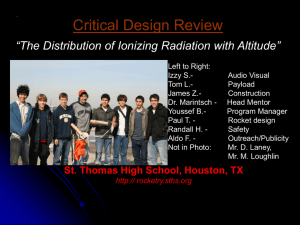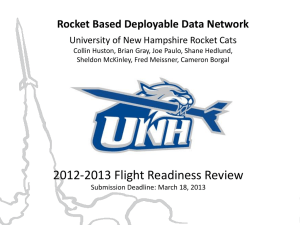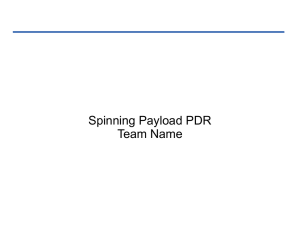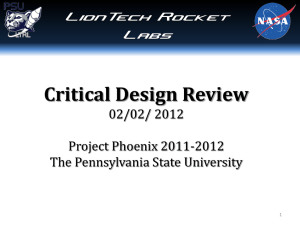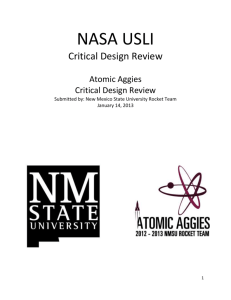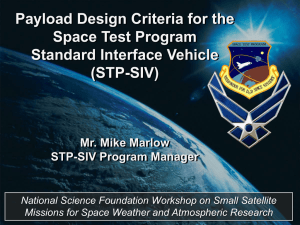Presentation
advertisement
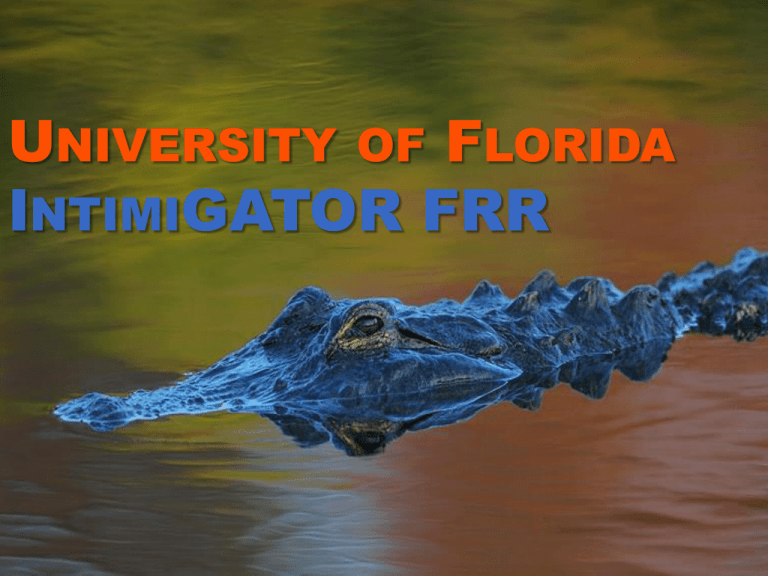
UNIVERSITY OF FLORIDA INTIMIGATOR FRR OUTLINE Overview System Design Recovery Design Payload Design Simulations and Performance Testing PROJECT SUMMARY Launch Vehicle The launch vehicle is designed to reach an altitude of a mile It contains 3 separate payloads: The Science Mission Directorate payload measures atmospheric conditions and allows the calculation of lapse rate The Lateral Flight Dynamics payload collects data on the vehicle’s roll rate for analysis The Flow Angularity and Boundary Layer Development payload aids the team in knowing the vehicle orientation There is dual-deployment recovery, with separate drogue and main parachutes for the SMD payload lander and launch vehicle OUTLINE Overview System Design Recovery Design Payload Design Simulations and Performance Testing SYSTEM VEHICLE DIMENSIONS Diameter: 6 inches Length: 115 inches Weight: 30 lbs Section Nosecone 24 Upper Airframe 44 Avionics Bay 3 Mid Airframe 16 Lower Airframe 28 Total Component Fins (2 with rollerons and 2 without) Pneumatics Bay Main Parachute/Shock Cord and Piston Weight (lbs) 5 1.5 3 Avionics Bay 3.25 Payload and Main Drogue Parachute Piston 0.25 Payload Main Parachute and Housing Drogue Parachutes and Shock Cord 5 1.5 Nosecone and Pressure Payload 4.25 Body Tube 6.25 Total 30 Length (in) 115 STATIC STABILITY MARGIN CG = 74.2” CP = 91.1” The static stability margin is 2.78 FINS Fins and mount made from ABS plastic on a rapid prototype machine Dimensions: Root Cord 11" Tip Cord 6” Span 6" Max Thickness .5" MOTOR SELECTION Cessaroni L1720 WT 1755 grams of propellant Total impulse of 3660 N-s 2.0 second burn time Altitude of 5280 feet 2.2 pound margin for error OUTLINE Overview System Design Recovery Design Payload Design Simulations and Performance Testing VEHICLE RECOVERY Dual Deployment Drogue release at apogee Main release at 700 ft AGL Drogue Parachute 36 inches in diameter Descent velocity of 65 ft/s Main parachute 96 inches in diameter Descent velocity 18 ft/s Recovery harness 5/8” nylon 25ft nosecone-upper 35ft lower-upper VEHICLE RECOVERY SYSTEMS Drogue parachute Directly below nosecone Released during first separation event Main parachute Housed in middle airframe between avionics bay and pneumatics bay Released during second separation event Separation between pneumatics bay and middle airframe SMD PAYLOAD RECOVERY Dual Deployment Drogue release at apogee Main release at 700 ft AGL Drogue Parachute 36 inches in diameter Descent rate of 25 ft/s Main Parachute 36 inches in diameter Descent rate of 12.5 ft/s Recovery harness 3/8” nylon 10-15 ft SMD PAYLOAD RECOVERY SYSTEMS Drogue parachute Released during first separation event Housed directly below vehicle drogue parachute Main parachute Released from parachute housing during secondary payload separation event stored in housing and ejected using a piston system KINETIC ENERGY AT KEY POINTS Launch Vehicle and SMD Payload Kinetic Energy During Decent (Under Drogue) Component Kinetic Energy (ft-lbf) Nose Cone 140.01 Airframe (Lower, Mid; shear pinned) 683.57 Payload 58.54 Kinetic Energy at Landing (Under Main) Component Kinetic Energy (ft-lbf) Payload 18.9 Nose Cone 14.9 Top Body Tube 39.8 Middle/Bottom Body Tube 57.4 OUTLINE Overview System Design Recovery Design Payload Design Simulations and Performance Testing SCIENCE MISSION DIRECTORATE PAYLOAD – OBJECTIVES AND REQUIREMENTS Objective To calculate the environmental lapse rate Requirements Measure temperature, pressure, relative humidity, solar irradiance, and UV radiation as a function of altitude GPS readings and sky-up oriented photographs Wireless data transmission SCIENCE MISSION DIRECTORATE PAYLOAD Rests in the upper airframe on top of a piston Ejects from the rocket at apogee Dual deployment recovery SCIENCE MISSION DIRECTORATE PAYLOAD Payload legs spring open upon ejection Some atmospheric sensors mounted on the lid Body made of blue tube for data transmission purposes SCIENCE MISSION DIRECTORATE PAYLOAD DESIGN Arduino Microcontroller Weatherboard Compared to the pre-programmed output from the Weatherboard XBee Pro 900 Senses atmospheric data and transmits to the microcontroller using synchronous communication Analog sensors Samples analog sensors and reads outputs from Weatherboard and GPS Sends data back to ground station Camera Takes sky-up oriented video LATERAL FLIGHT DYNAMICS (LFD) Objectives Introduce a determinable roll rate during flight after burnout Derive ODEs of the rockets roll behavior Use linear time invariant control theory to evaluate roll dampening using rollerons Determine percent overshoot, steady state error, and settling time Requirements Ailerons deflect with an impulse to induce roll Rollerons inactively dampen roll rate LFD Procedures (after burnout) Phase I Ailerons impulse deflect Rollerons locked Rocket naturally dampens its roll rate Phase II Ailerons impulse deflect Rollerons unlocked Rollerons dampen out roll rate LFD FIN LAYOUT Uses pneumatic actuators to unlock rollerons and deflect ailerons Rollerons locked using a cager Rolleron Cager Aileron Aileron Actuator LFD MANUFACTURING All components locally manufactured Wheel on Mill Finished Wheel Casing LFD ASSEMBLED FIN LFD AIR TANK SPECIFICS AND FAILURE MODES Ailerons fail in the neutral position Loss of air pressure fails to the neutral position Air Tank Type 14.5 cu. In. AL 150psi pressure tank Material AL with sealed steel cap Used for providing pressure to the pneumatic cylinders MEOP 150psi Safety Factor 2 LFD ANALYSIS Roll data points analyzed using numerical methods Plots roll characteristics Derives an ODE Linear Time Invariant Control Theory Governing equation - ODE transformed into Laplace form (frequency domain) Impulse function (R(s) = 1) is applied to the plant (Gp) From the plants denominator the frequency can be determined FLOW ANGULARITY Objectives Take differential pressure readings from each transducer Determine angularity and boundary layer properties Requirements Pre-calibration in wind tunnel will result in nondimensional coefficients Can be compared to flight results to obtain angularity Calibration involves testing probe at multiple angles and flow velocities FLOW ANGULARITY SCHEMATICS FLOW ANGULARITY ANALYSIS Non-dimensional coefficients OUTLINE Overview System Design Recovery Design Payload Design Simulations and Performance Testing FLIGHT SIMULATIONS Used RockSim and MATLAB to simulate the rocket’s flight MATLAB code is 1-DOF that uses ode45 Allows the user to vary coefficient of drag for different parts of the rocket After wind tunnel testing, can get fairly accurate CD values that can be used in the program PERFORMANCE MATLAB code is compared with RockSim Maximum altitude predictions separated by 713 ft due to Cd value differences Led to design changes maximum altitude predicted by RockSim of 5475 ft MATLAB predicts 4772 ft Room for unexpected mass or drag due to the simulations reaching over one mile PERFORMANCE Thrust-to-weight ratio 12.98 Need above 1 for lift-off Rail exit velocity 76.8 ft/s DRIFT CALCULATIONS IntimiGATOR Drift SMD Payload Drift Launch Angle (deg) 0 0 0 0 5 5 5 5 10 10 10 10 Wind (mph) 0 5 10 15 0 5 10 15 0 5 10 15 Range (ft) 0 780.73 2335.4 2535.58 963.96 202.77 678.22 1608 1886 934.5 120.1 622.9 OUTLINE Overview System Design Recovery Design Payload Design Vehicle Optimization Simulations and Performance Testing COMPONENT TESTING SUMMARY All components of the launch vehicle and three payloads have planned tests 21 tests outlined in detail in FRR report Ensure all design details will work as expected Allow the team to make necessary adjustments Make sure the vehicle has a successful competition launch SOME COMPLETED TESTS Test # 2 Components Tested Body Tube Testing Details Reason For Test Results Determine the strength of the charge necessary to separate the different sections of the rocket by trying different sized charges Defer any complications during flight and ensure the rocket can separate Ejection charges were more than adequate to separate the rocket tube 10 Full-Scale Static Motor Test Determining the thrust curve of the motor Determine whether the rocket motor has enough force to launch rocket and its components to desired height Motor test was successful, and had enough thrust to get the rocket to required height 12 Analog Readings, Temperature, Humidity, Solar, Pressure, UV Sensors will be placed in the payload to record data. Compare outputs with the digital weatherboard reads to ensure accuracy Humidity and Temperature Sensors tested and function properly others to be tested during January 14 XBee's Send sensor data and receive it on computer Required for USLI competition Successful was able to send 9 Degrees of Freedom data back to the ground station during Subscale launch SUBSCALE RESULTS Launched with Aerotech J500 3 separate times 1st subscale launch had a successful deployment of the SMD mock payload 2nd subscale launch showed that the SMD Main parachute housing was successful 3rd subscale launch included the LFD payload fins with the rollerons unlocked Rocket remained completely stable throughout flight and visually showed no roll FULL SCALE LAUNCH Occurred on March 17, 2012 Launched with a Cesaroni L1720WT Reached an altitude of 4294 ft. Sustained some damage on impact due to no main parachute deployment FULL SCALE LAUNCH- LACK OF ALTITUDE Upper airframe launched was 4” longer than designed Centering rings attached with screw inserts that sheared off Motor impulse was not fully transferred to the rocket Coefficient of drag may be higher than anticipated A scale model of the rocket is being rapid prototyped to perform wind tunnel testing FULL SCALE LAUNCH- RECOVERY Separation did not occur at the main event at 700ft AGL Multiple further tests are being performed to ensure separation SPONSORS NASA Boeing Millennium Engineering and Integration Northrop Grumman Pratt & Whitney Acquip, Inc. University of Florida QUESTIONS? COMMUNITY OUTREACH Gainesville High School 400 students throughout the school’s 6 periods Interactive PowerPoint Presentation covering the basics of rocketry Derivations of relatable equations Model rocket launches COMMUNITY OUTREACH PK Yonge Developmental and Research School 150 6th grade students Interactive PowerPoint Presentation with videos Model rocket launches




